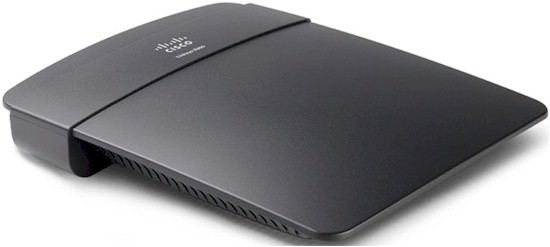
| At a glance | |
|---|---|
| Product | Linksys Wireless-N300 Router (E900) [Website] |
| Summary | Inexpensive 2.4 GHz N300 router with 10/100 ports based on a Broadcom N Router SoC. |
| Pros | • Relatively inexpensive • 100 Mbps wire-speed routing |
| Cons | • No guest WLAN • No Internet service or URL blocking |
Typical Price: $20 Buy From Amazon
Introduction
In a nod toward what most people still are buying these days, we’re testing a few popular N300 and N600 class routers to flesh out the Charts, Finders and Rankers a bit more. This time I’m taking a quick look at Linksys’ current entry-level N router, the E900.
We’ve actually seen this guy before as the Linksys E1200. So this review will mainly focus on the performance test results. It will also cover the E1200 v2, since as you’ll see shortly, it’s essentially the same as the E900.
According to Wikidevi, the E900 also uses same raw board as a Linksys E800. We’ll come back to that when I look at the innards.
The E900 has the design aesthetic of the rest of Linksys’ E series routers being designed to sit flat on a desk or shelf and without mounting slots on the bottom for wall-hanging. The single WAN and four switched LAN ports shown in the photo below are all 10/100 and there is no USB port for drive or printer sharing. The top of the router is clean and has no indicators to light you your bedroom at night. The callouts for the ports, indicators and buttons are shown below.
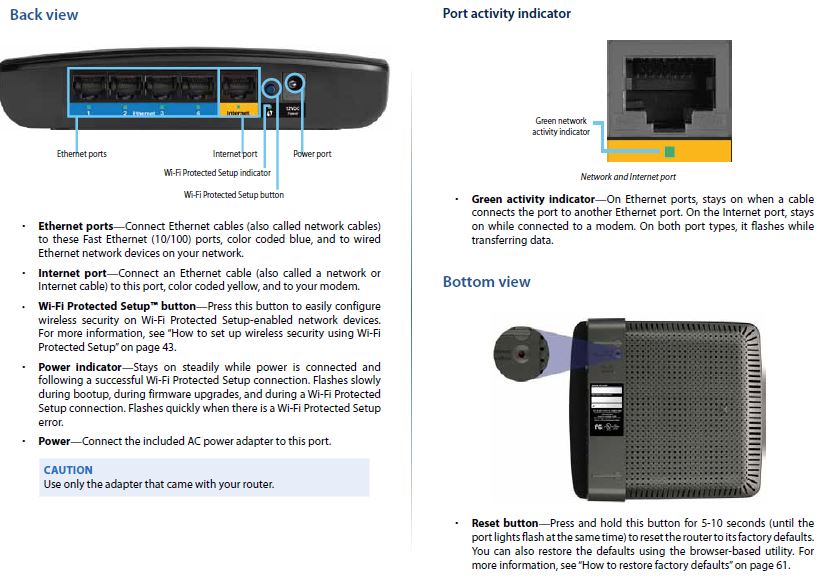
Linksys E900 callouts
Inside
As noted above, the E900 is the same beastie as the E1200 v2. I forgot I already discovered this, but a look at Inside Story: Cisco Linksys EA Series reminded me. (The same board is also used in the N150 class E800 available at Target.) As the Inside Story points out, the hardware is the same for the E900 and E1200. But the E1200 supports guest access and Parental Controls while the E900 does not. The E900 is also dark grey, while the E1200v2 is black.
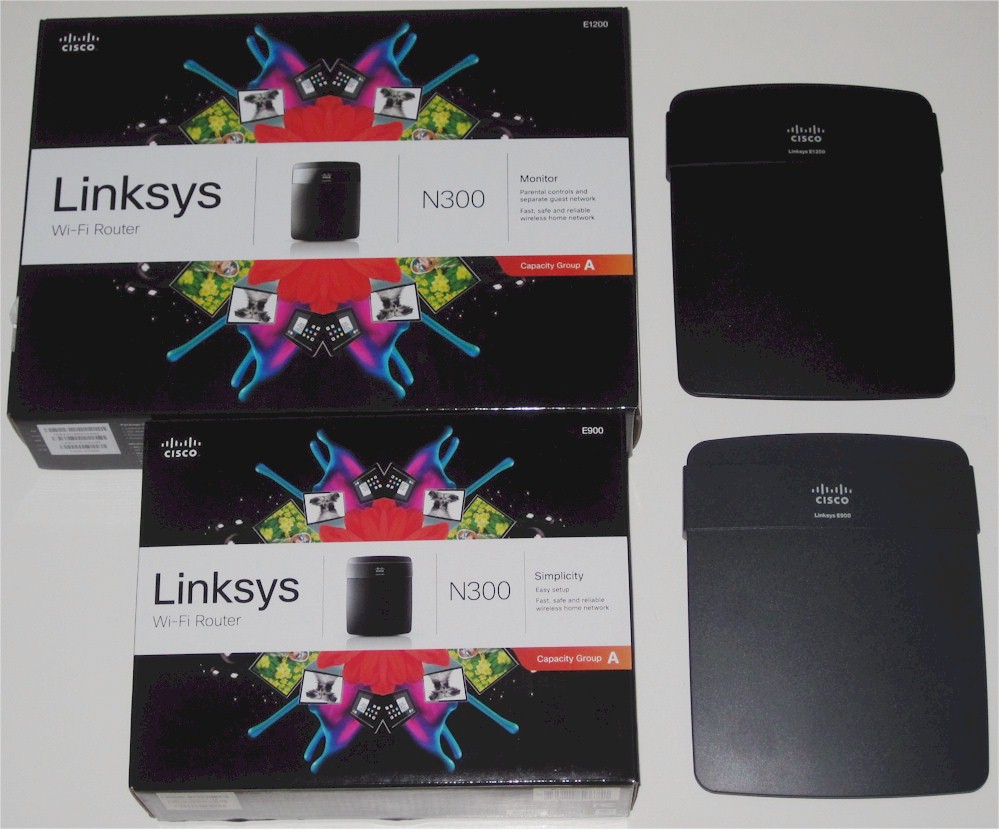
Linksys E900 & E1200 compared
The board shot below shows the simple design, based around the Broadcom BCM5357 Intensi-fi XLR 802.11n Router Solution SoC. This device was also used in the original E1200 and in the E1500. It is also used in the NETGEAR WN3000RP and Linksys RE1000 wireless extenders, reviewed in the Single Band Wireless Extender Roundup.
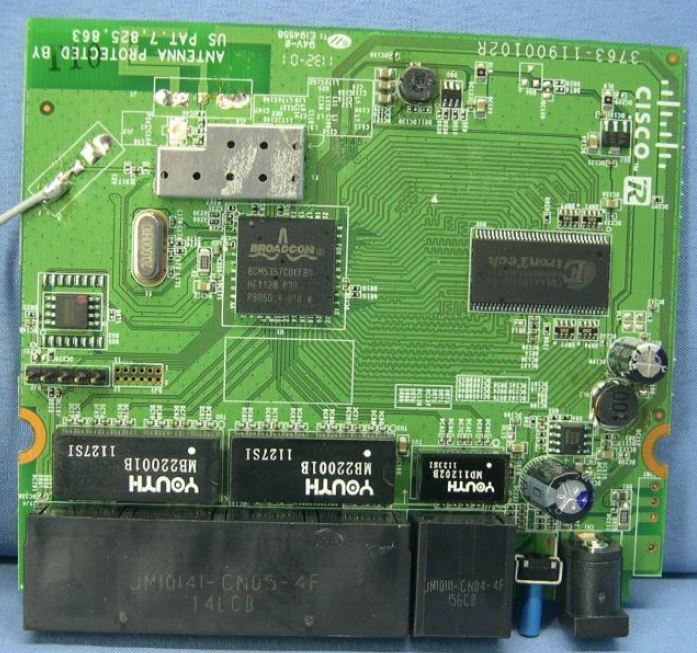
Linksys E900 / E1200v2/ E800 board
The key components are summarized in Table 1.
| Linksys E900 (& E1200v2 & E800) | |
|---|---|
| CPU | Broadcom BCM5357C0 Intensi-fi XLR 802.11n Router Solution |
| Switch | In BCM5357 |
| RAM | 32 MB |
| Flash | 8 MB |
| 2.4 GHz Radio | In BCM5357 |
Table 1: Component summary
Features
The E900 supports the older standard Linksys router feature set, slightly enhanced to support IPv6. Supported are IPv6-Auto mode internet connection, 6rd tunnel and IPv6 firewall rules. A quick rundown of the features is:
- DHCP, Static, PPPoE, PPTP, L2TP, Telstra Cable WAN types
- DHCP server with MAC address reservation
- Built-in Dynamic DNS clients for TZO and DynDNS
- Static and dynamic routing
- SPI firewall disable, multicast, WAN ping and IDENT filtering and Proxy, Java, ActiveX and Cooking blocking
- IPsec, PPTP and L2TP VPN passthrough (enabled by default)
- Single port forwarding and Port Range forwarding and triggered ports
- HTTPS admin access, remote management (HTTP / HTTPS) enable with IP range restriction and port setting
- Incoming, outgoing, Security and DHCP onscreen log access with support for Linksys Logviewer recording
- Uplink (LAN to WAN) only QoS with High, Medium, Normal or Low Priority that can be applied to specific applications (divided into Application, Online Game and Voice Device groups), physical switch ports or specific MAC addresses.
- WMM (Wireless MultiMedia) (enabled by default)
After plugging in the router and launching a browser, you’re reminded of the E900’s heritage in the capture page you are redirected to. The Cisco logo is still there, as is instructions for installing Cisco Connect (don’t bother).
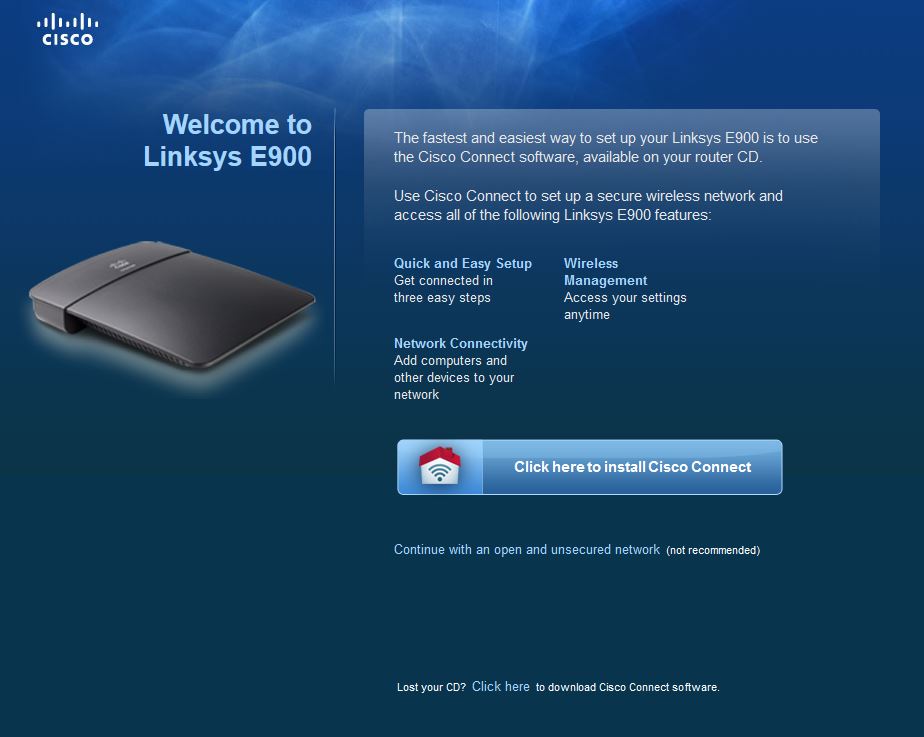
Linksys E900 – first browser access
As noted earlier, the main difference between the E900 and E1200 is that the E1200 supports wireless guest network access and simple parental controls. If you do opt for an E1200, the parental controls (below) are very basic and don’t include specific service blocking.
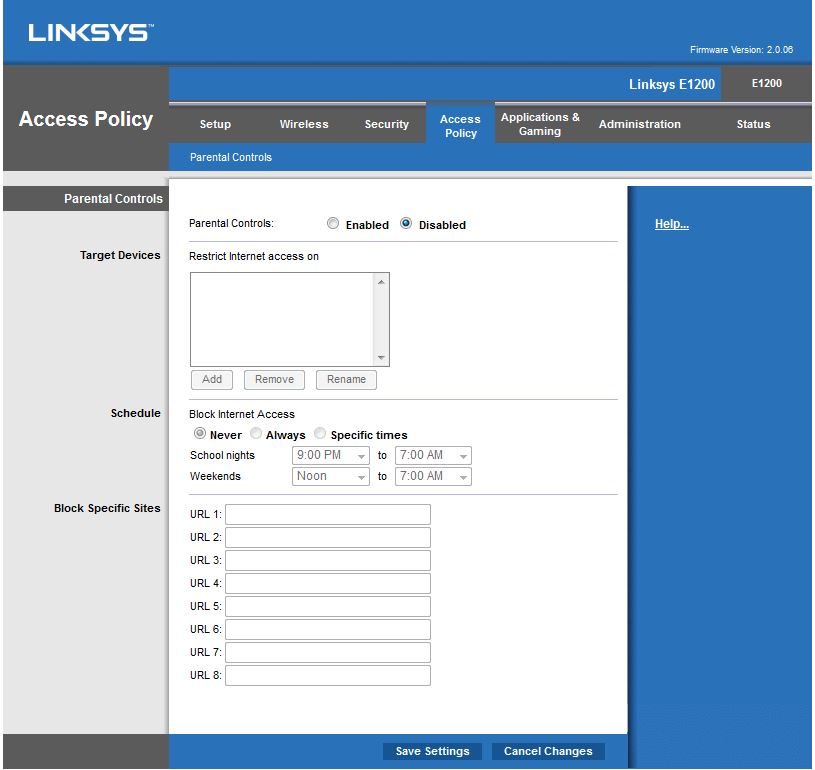
Linksys E1200 Parental Controls
And no, you can’t load E1200 firmware onto the E900. I tried.
Routing Performance
Routing performance for the E900 loaded with V1.0.04 firmware using our standard test method is summarized in the table below. I also included the results for the E1200 v1 for comparison. ![]()
Looks like a few tweaks were made in the E900’s more recent firmware that increased routing performance a bit and raised the 8K cap on simultaneous connections that the E1200 v1 had.
| Test Description | Linksys E900 | Linksys E1200 v1 |
|---|---|---|
| WAN – LAN | 94.1 | 91.7 |
| LAN – WAN | 94.0 | 90.8 |
| Total Simultaneous | 149.6 | 117.8 |
| Maximum Simultaneous Connections | 11,728 | 8,192 |
| Firmware Version | 1.0.04 | 1.0.00 build 11 |
Table 2: Routing throughput
For the unidirectional tests, the IxChariot chart below shows very steady and equal throughput in both directions.
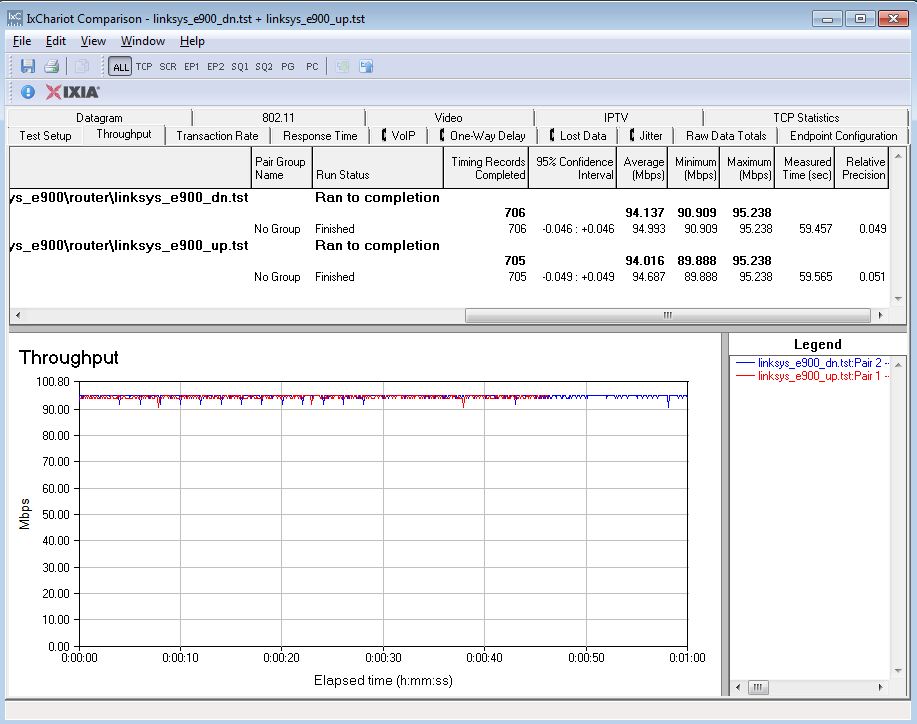
Linksys E900 routing unidirectional throughput
Simultaneous up/down performance shows more variation, but a bit of a bump up to 75 Mbps in each direction for just shy of 150 Mbps total.
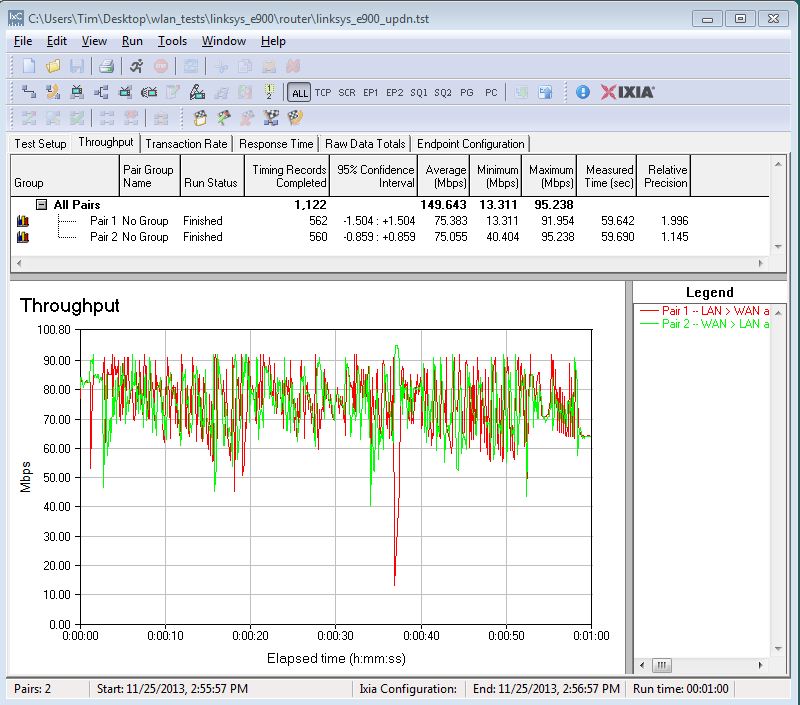
Linksys E900 routing bidirectional throughput
Wireless Performance
The E900 is Wi-Fi Certified. It defaulted to Auto channel mode and Auto (20 / 40 MHz) Channel bandwidth mode upon power-up. The router defaults to a unique SSID based on the router’s serial number.
WPS is enabled by default and produced a PIN session prompt when I associated a Win 7 client. The WPS session completed successfully in a WPA2/AES connection.
The 40 MHz Coexistence and Fat channel intolerant tests yielded mixed results. The router immediately fell back to 20 MHz when the Fat Channel intolerant bit was set. But it did not restore to 40 MHz bandwidth when bit was cleared. The 40 MHz coexistence test failed, with the E900 continuing to use a 40 MHz wide channel even when the router’s upper channel was set to 9.
All wireless performanc tests were run using our standard wireless test process and 1.0.04 version firmware loaded. The router was first reset to factory defaults, then set to Channel 6 and 20 MHz B/W mode. The closest surface of the router was positioned 8″ from the chamber antennas in all test positions. The 0° position had the front of the router facing the chamber antennas.
The Benchmark Summary below shows the average of throughput measurements made in all test locations.
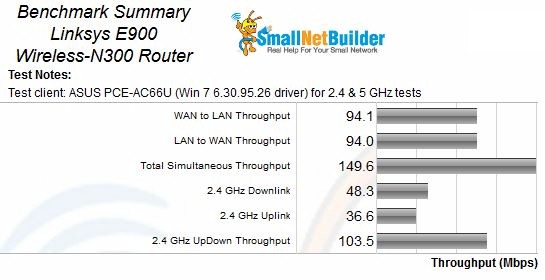
Linksys E900 Benchmark Summary
Craig’s Medialink MWN-WAPR300N review laid the groundwork for putting the E900’s performance in perspective. His 2.4 GHz downlink chart filtered for most recent reviews and N300 class routers shows the E900 and Medialink running neck-and-neck.
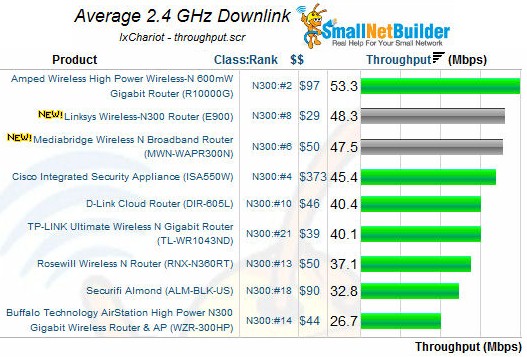
N300 2.4 GHz downlink comparison (green, gray bar filters applied)
The filtered uplink chart shows a larger gap in performance with the E900’s average throughput around 10 Mbps lower.
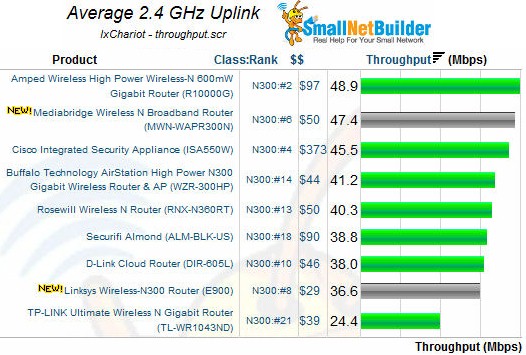
N300 2.4 GHz uplink comparison (green, gray bar filters applied)
Craig did a nice comparison of the Medialink’s performance with a few AC1200 routers and the E900. I’m going to keep it simple and just compare the Medialink N300 and E900 as N300 routers.
For the 2.4 GHz downlink profile plot shows the E900 starts out with higher throughput, but begins its decline much sooner than the Medialink and disconnecting at the 60 dB attenuation point. Since this is what we use for range ranking, the E900 definitely takes a hit here.
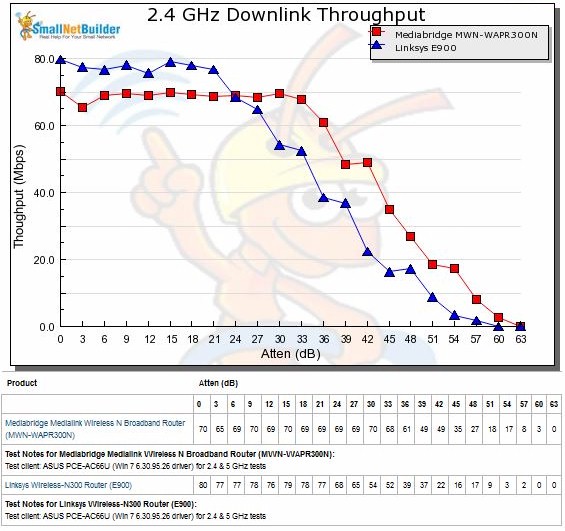
2.4 GHz Downlink Throughput vs. Attenuation
The 2.4 GHz uplink profile shows a similar story to downlink, but with the E900’s throughput starting to fall off almost immediately. It rallies a bit at 42 dB, but still disconnects at 60 dB of attenuation.
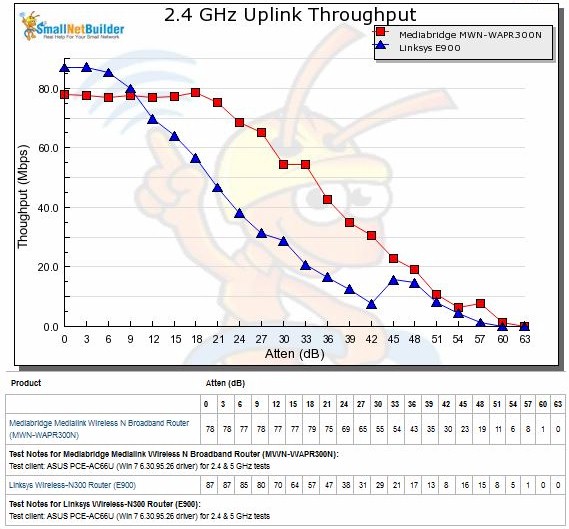
2.4 GHz Uplink Throughput vs. Attenuation
All this means is that the E900 has higher peak throughput, but doesn’t have the range that the Medialink N300 provides.
Closing Thoughts
The Router Ranker scores the E900 two positions below the Medialink MWN-WAPR300N with total rank scores of 9.8 and 9.0, respectively (lower score is better). The performance summary shows the main reason for the lower score is the very low range rank, which comes from the 0 Mbps values at the 60 dB attenuation measurement point.
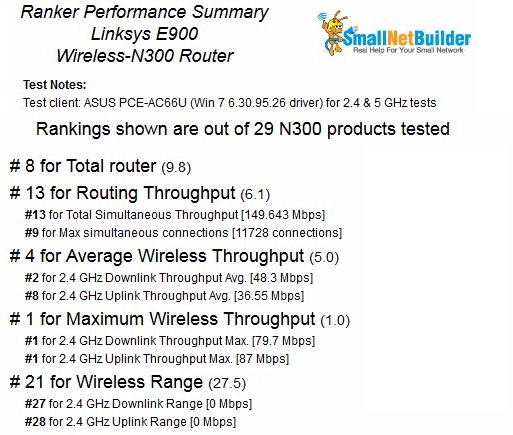
Linksys E900 Ranking Performance Summary
If you are looking for lower cost and don’t mind reduced coverage, the Linksys E900 is a decent choice for a basic N300 class router. If you don’t mind spending about $10 more, the E1200v2 will perform the same, but adds guest wireless and basic parental controls. If you’re ok parting with around $50, then you might want to try the Medialink MWN-WAPR300N.
